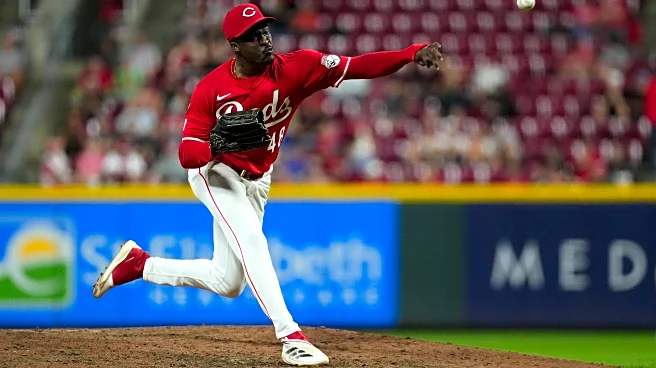What's Happening?
The St. Louis Cardinals' minor league system has been ranked as the number one system in Major League Baseball by Fangraphs. This marks a significant improvement from last year when the system was ranked 21st.
The leap in ranking is attributed to the Cardinals' strategic trades and successful draft picks, which have bolstered their prospect depth. The team has increased its number of ranked players from 41 to 49, with notable additions from the 2025 trade deadline and draft. The system's value is now estimated at $283 million, surpassing last year's top-ranked Tampa Bay Rays. The Cardinals have achieved this with fewer prospects than other top systems, indicating a focus on quality over quantity.
Why It's Important?
This development is crucial for the Cardinals as it enhances their competitive edge in MLB. A strong minor league system provides a pipeline of talent that can be leveraged for future success in the major leagues. The Cardinals' focus on quality prospects, particularly in pitching and outfield positions, aligns with their major league roster needs. This strategic alignment could lead to improved team performance and long-term success. Additionally, the Cardinals' rise in rankings reflects effective management and scouting, which could influence other teams to adopt similar strategies.
What's Next?
The Cardinals will likely continue to develop their prospects, focusing on maintaining the quality of their minor league system. As these players mature, they may be integrated into the major league roster, potentially enhancing team performance. The organization will also need to manage injuries and player development to sustain their top ranking. Other teams in the NL Central, such as Pittsburgh and Milwaukee, are close behind in system valuation, indicating a competitive division landscape. The Cardinals will need to capitalize on their current advantage to maintain their lead.
Beyond the Headlines
The Cardinals' rise in minor league rankings highlights the importance of strategic planning and investment in player development. This approach not only strengthens the team's future prospects but also sets a benchmark for other MLB teams. The focus on quality over quantity in player development could lead to a shift in how teams evaluate and manage their minor league systems. Additionally, the Cardinals' success may influence broader trends in scouting and player valuation across the league.













